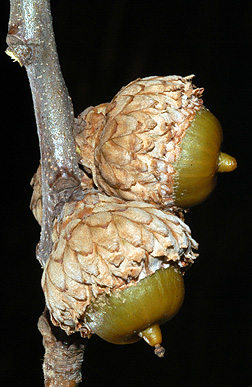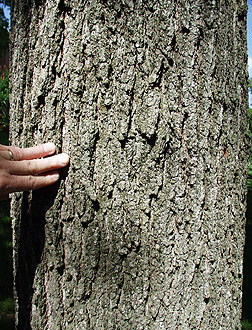black oak Fagaceae Quercus velutina
Leaf:Alternate, simple, 4 to 10 inches long, obovate or ovate in shape with 5 (mostly) to 7 bristle-tipped lobes; leaf shape is variable, with sun leaves having deep sinuses and shade leaves having very shallow sinuses, lustrous shiny green above, paler with a scruffy pubescence and axillary tufts below.
Flower:Species is monecious; males borne on slender yellow-green catkins; females are reddish green and borne on short spikes in leaf axils, appearing in spring with the leaves.
Fruit:Ovoid acorns, 1/2 to 3/4 inch long, 1/3 to 1/2 enclosed in a bowl-shaped cap; cap scales are loosely appressed (particularly loose on edges of cap), light brown and fuzzy, matures in 2 years in late summer and fall.
Twig:Stout and red-brown to gray-green, usually glabrous but rapidly growing twigs may be hairy; buds are very large (1/4 to 1/2 inch long), buff-colored, fuzzy, pointed and distinctly angular.
Bark:At first gray and smooth, becoming thick and very rough, nearly black and deeply furrowed vertically with horizontal breaks. The inner bark is yellow-orange and very bitter tasting.
Form:A medium sized tree to 80 feet with an irregular crown and a tapering, somewhat limby bole.







Notes: